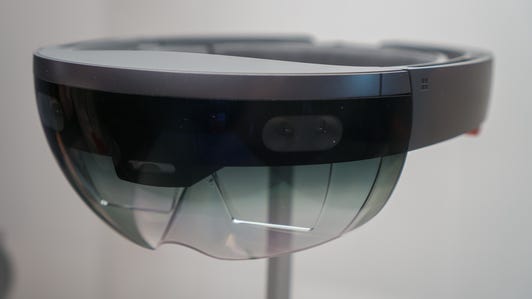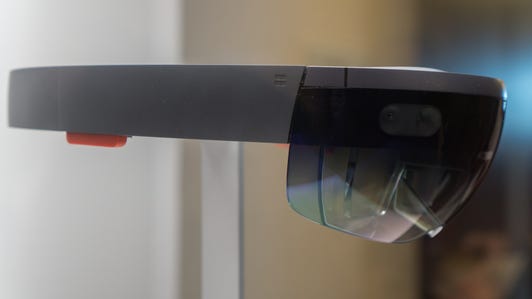 Enlarge Image
Enlarge ImageCNET
SAN FRANCISCO — Microsoft may not be the only game in town when it comes to HoloLens augmented-reality glasses.
Asus, the world’s sixth-biggest PC maker, is talking with the Windows software maker about building its own version of Microsoft’s HoloLens , Jonney Shih, Asus’ chairman, and Terry Myerson, Microsoft’s executive vice president of Windows and devices, have told CNET.
Asus’ interest in becoming the first outside company to build a version of Microsoft’s device could give a boost to augmented reality, which projects 3D images in front of your eyes and overlays them on real-world environments. No version of HoloLens is on the market yet. Microsoft is expected to release a version for software developers for $3,000 in early 2016. That move is designed to spur developers to create HoloLens apps that will appeal to consumers.
Taiwan-based Asus, known for building affordable PCs, could eventually create a less expensive version of the glasses that may end up in your home. For Redmond, Washington-based Microsoft, the hope is that many companies will adopt the technology, which was introduced in January and runs Windows 10.
See also
- Microsoft’s HoloLens priced at $3,000 for developer edition, shipping Q1 2016
- How Microsoft became a control freak with tablet makers
- Our inside look at Microsoft’s HoloLens leaves us wanting more
- Lost Explorers: The unrealized vision of Google Glass
- Microsoft’s HoloLens explained: How it works and why it’s different
“Everything we’re doing in hardware, we do with the mind of how do we grow the Windows ecosystem,” Myerson said. “That is why we’re investing to create a category.”
It’s ultimately up to Shih whether Asus makes its own version of HoloLens, Myerson added. Shih said he’s “still evaluating” what form any potential Asus augmented-reality glasses will take.
“Wait and see,” he said.
As for Microsoft’s HoloLens, Myerson declined to say when his company may begin selling a cheaper version meant for consumers. But there will be signs when it’s primed for market.
“When my kids can’t put the Minecraft on HoloLens down,” he said, “we know it’s ready for Minecraft players.”
The HoloLens version of Microsoft’s Minecraft, a wildly popular game in which players use textured cubes to build a 3D world, has impressed crowds. CNET earlier this year called Minecraft the .
Take a closer look at the Microsoft HoloLens (pictures)






+3 more
Surface tension
Shih and Myerson were in San Francisco earlier this month for an Asus event to reveal new gaming PCs. The two companies have partnered closely over the years, though they haven’t always been the best of friends. Along with making Windows PCs and tablets, Asus sells devices based on Google’s Android software. Meanwhile, Microsoft didn’t tell PC makers about its original Surface tablet until shortly before unveiling the device in 2012, something that caused tension between Microsoft and its computer partners.
Ultimately, Microsoft said it created Surface to spur innovation in the computer industry and show consumers the kinds of devices that were possible under Windows. Since then, all of the major PC makers have released similar products.
Earlier this month, Microsoft again put a stake in the ground on computer design by introducing its first laptop, the Surface Book. The 13.5-inch Windows 10 device starts at $1,499. Microsoft once again says it wants to inspire its partners.
“We don’t want to compete with Asus,” Myerson said. “That’s not our goal….We want people to come home to Windows.”


Now playing:
Watch this:
The evolution of Microsoft’s HoloLens
3:15
Rethinking Google Glass
One device Asus probably won’t be making is a headset based on the first version of Google Glass, which Shih views as “too much limited” by its user interface and a lack of capabilities.
Glass, which Google first showed off in 2012, connected to the Internet and overlaid images and graphics over what wearers saw with their own eyes. The $1,500 device included apps with basic functionality, like Facebook’s app that allowed people to upload photos from Google Glass directly to their Facebook timeline.
Google Glass and the lost Explorers (pictures)






+8 more
The lightweight headgear, unlike the bulkier HoloLens, was meant to be worn in public or at home, but its camera caused an outcry over potential privacy violations and led some venues to ban the technology.
Google paused the project in January, halting its Google Glass Explorer program and discontinuing production of its prototype. It has been reportedly working on a new model it hopes will be less alienating to the public.
The main reason the first version of Google Glass wasn’t successful, Shih said, was because the technology didn’t “make it really AR.” Glass didn’t have enough smarts to accomplish things that were really useful to consumers, he said.
Google didn’t provide a comment to CNET.
“When it really takes advantage of the cloud…[and has] this kind of augmented-reality advantage,” Shih said, “then the market can really move forward.”
Corrected at 7:45 p.m. PT to reflect Shih’s chairman title.



